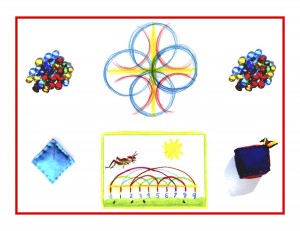Day 107
For one year, 365 days, this blog will address the Common Core Standards from the perspective of creating an alternate, ambient learning environment for math. Ambient is defined as “existing or present on all sides, an all-encompassing atmosphere.” And ambient music is defined as: “Quiet and relaxing with melodies that repeat many times.”
Why ambient? A math teaching style that’s whole and all encompassing, with themes that repeat many times through the years, is most likely to be effective and successful. Today’s standard will be listed in blue, followed by its ambient counterpart.
Number and Operations in Base Ten 1.NBT
Use place value understanding and properties of operations to add and subtract.
5. Given a two-digit number, mentally find ten more or ten less than the number, without having to count; explain the reasoning used.
Having explored the -teens and -ty’s through stories, pictures, and hands-on activities, it’s now possible to find the next ten, up or down, of any number. The -ty’s lesson showed that the multiples of ten are basically the same as counting in ones. It was seen that some of the ‘ty’s change their names and some don’t. For example, two becomes twenty, three becomes thirty, four becomes forty, five becomes fifty, but six stays sixty, seven: seventy, eight: eighty, and nine: ninety.
Armed with this inside information the first grader can confidently proceed, knowing that it’s all just counting, using the same numbers! So then it’s just simple mental calculation to go up and down the tens ladder. Take ten away from seventy two = sixty two. Being able to count from 1-10 forward and backward makes all of this possible. Here’s a foundational place value activity/lesson.
Gather twenty or so palm-sized flat, smooth stones. (We’re living in rock heaven here, with four major rivers nearby.) If none are readily available outdoors, your local garden supply should have a nice selection of stones for sale. Have your child write the numbers 0 – 9, one number per stone, two stones for each number. Line up the number stones 1-9 in a vertical column, then take the other stones, randomly one at a time, and place each one next to the numbers in the first column, having the child say each number while doing this. For example, with the 3 stone it would be thirteen, twenty three, thirty three, etc. Physically moving the numbers up and down are a good hands-on means of exploring ten more and ten less.
This could inspire morning circle activities as well: 1) Toss a ball or bean bag while saying, “sixty six, ten less” and have the child toss it back with the answer, “fifty six.” 2) Have the child toss a ball or bean bag from hand to hand / toss it up and catch it / pass it from front to back and back to front while saying several tens in a row, “forty three, fifty three, sixty three.” 3) Marching in a circle with your child, say a number as the second digit and have the child say the -ty’s with it while marching: you say, seven s/he says, seventeen, twenty seven, thirty seven . . . and so on, up to ninety seven. Add some lively fun to this last one with a tambourine, rhythm sticks, a small drum, etc. “Explaining the reasoning used” can wait until there’s the capacity for abstract thinking at 11 or 12.
As always, it’s the movement, story, and art that win the day with math! Knowledge ensues in an environment dedicated to imaginative, creative knowing, where student and teacher alike surrender to the ensuing of that knowledge as a worthy goal. More Common Core Grade 1 Number and Operations in Base Ten Standards with their ambient counterparts tomorrow!












